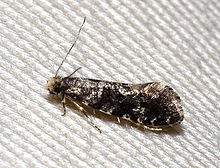
Back سوسيات فراشية Arabic سوسيات فراشيه ARZ Tineidae AST Tinèids Catalan Tineidae CEB Molovití Czech Echte Motten German Tineedoj Esperanto Tineidae Spanish Koilased Estonian
| Tineidae Temporal range: Late Eocene to present
| |
|---|---|

| |
| Adult European grain moth (Nemapogon granella: Nemapogoninae) from Graz, Austria | |
| Scientific classification | |
| Domain: | Eukaryota |
| Kingdom: | Animalia |
| Phylum: | Arthropoda |
| Class: | Insecta |
| Order: | Lepidoptera |
| Superfamily: | Tineoidea |
| Family: | Tineidae Latreille, 1810 |
| Type genus | |
| Tinea | |
| Subfamilies | |
| |
| Diversity[1] | |
| About 357 genera and 2,393 species | |
Tineidae is a family of moths in the order Lepidoptera described by Pierre André Latreille in 1810. Collectively, they are known as fungus moths or tineid moths. The family contains considerably more than 3,000 species in more than 300 genera. Most of the tineid moths are small or medium-sized, with wings held roofwise over the body when at rest. They are particularly common in the Palaearctic, but many occur elsewhere, and some are found very widely as introduced species.
Tineids are unusual among Lepidoptera as the larvae of only a very small number of species feed on living plants, the majority feeding on fungi, lichens, and detritus. The most familiar members of the family are the clothes moths, which have adapted to feeding on stored fabrics and led to their reputation as a household pest. The most widespread of such species are the common clothes moth (Tineola bisselliella), the case-bearing clothes moth (Tinea pellionella), and the carpet moth (Trichophaga tapetzella); the brown-dotted clothes moth (Niditinea fuscella) despite its name, preferentially feeds on feathers in bird nests.
One remarkable genus is Ceratophaga, whose members feed exclusively on pure keratin in the form of the horns and hooves of dead mammals and even the shells of dead tortoises.